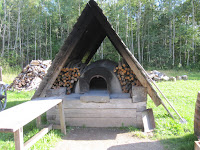It turns out that the Acadian culture and history became the highlight of that part of the trip. One of the real pleasures of travel is finding these surprises. All I knew before is that folks in Southern Louisiana came from Nova Scotia and were called Cajuns. I have since learned that Acadia (present day Nova Scotia) was founded by the French in 1604 and later ceded to Great Britain in 1703. While the power struggles between the French and Anglos were finally settled by 1763, the Acadians were casualties of that conflict. From 1755 to 1763, 2/3 of the Acadians or about 10,000 people were deported to the American colonies, Great Britain and France. Some fled to New Brunswick where they found sanctuary. This event is modernly referred to as "The Deportation." During this expulsion, the farms and homes of the Acadians were destroyed. Not only were the Acadians of French origin but they were Catholic. The Acadians were not welcome in the colonies and many later moved on to French islands in the Caribbean, as well as a still French island off Newfoundland. About 1000 of those sent to France subsequently chose to relocate in Louisiana, where the Spanish welcomed their fellow Catholics.
It seems that the lives of Acadians were second class in Canada until about 40-50 years ago when Acadian leadership in New Brunswick was able to create the only Province that is officially bilingual. Parents have the choice to send a child to a French or English school but the child must also learn the second language and become fluent. We had no difficulty with the language while traveling in the Acadian part of New Brunswick, unlike our experience in Quebec.
The New Brunswick provincial government runs an Acadian Village with about 40 restored or painstakingly recreated period buildings. Life is depicted from the mid 1700's (after Deportation) through the 1930's and staff are dressed in period clothes, enthusiastic and very well versed in the history of their particular time. I have been to Williamsburg in the US and this far surpasses that in size and accuracy. The staff easily shift from French to English depending upon the visitor's native tongue.
We spent an hour the first day and the whole next day visiting nearly every building and watching demonstrations and asking questions. The activities featured included:
Fiber Arts such as flax and preparing, spinning and weaving (the topic of another blog),
 |
| An Acadian Home in the mid 1700's |
 |
| Pot for dyeing wool with natural plant called Tansy |
 | ||
| Bread Oven |
 | ||
| Homes always had a root cellar |
 |
| The Acadian Flag flying over a recreated hotel |





